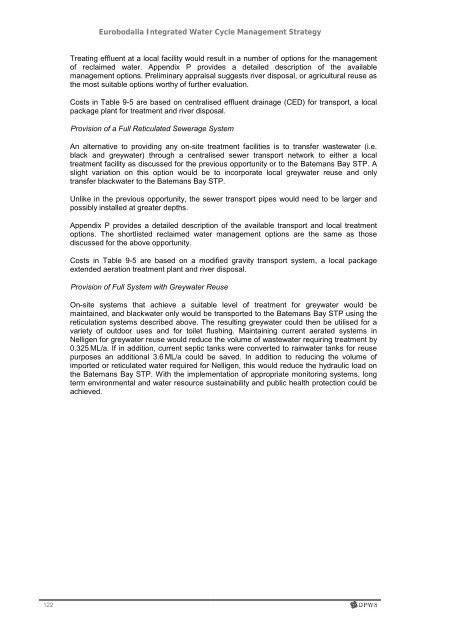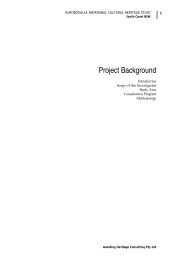Eurobodalla Integrated Water Cycle Management Strategy
Eurobodalla Integrated Water Cycle Management Strategy
Eurobodalla Integrated Water Cycle Management Strategy
You also want an ePaper? Increase the reach of your titles
YUMPU automatically turns print PDFs into web optimized ePapers that Google loves.
122<br />
<strong>Eurobodalla</strong> <strong>Integrated</strong> <strong>Water</strong> <strong>Cycle</strong> <strong>Management</strong> <strong>Strategy</strong><br />
Treating effluent at a local facility would result in a number of options for the management<br />
of reclaimed water. Appendix P provides a detailed description of the available<br />
management options. Preliminary appraisal suggests river disposal, or agricultural reuse as<br />
the most suitable options worthy of further evaluation.<br />
Costs in Table 9-5 are based on centralised effluent drainage (CED) for transport, a local<br />
package plant for treatment and river disposal.<br />
Provision of a Full Reticulated Sewerage System<br />
An alternative to providing any on-site treatment facilities is to transfer wastewater (i.e.<br />
black and greywater) through a centralised sewer transport network to either a local<br />
treatment facility as discussed for the previous opportunity or to the Batemans Bay STP. A<br />
slight variation on this option would be to incorporate local greywater reuse and only<br />
transfer blackwater to the Batemans Bay STP.<br />
Unlike in the previous opportunity, the sewer transport pipes would need to be larger and<br />
possibly installed at greater depths.<br />
Appendix P provides a detailed description of the available transport and local treatment<br />
options. The shortlisted reclaimed water management options are the same as those<br />
discussed for the above opportunity.<br />
Costs in Table 9-5 are based on a modified gravity transport system, a local package<br />
extended aeration treatment plant and river disposal.<br />
Provision of Full System with Greywater Reuse<br />
On-site systems that achieve a suitable level of treatment for greywater would be<br />
maintained, and blackwater only would be transported to the Batemans Bay STP using the<br />
reticulation systems described above. The resulting greywater could then be utilised for a<br />
variety of outdoor uses and for toilet flushing. Maintaining current aerated systems in<br />
Nelligen for greywater reuse would reduce the volume of wastewater requiring treatment by<br />
0.325 ML/a. If in addition, current septic tanks were converted to rainwater tanks for reuse<br />
purposes an additional 3.6 ML/a could be saved. In addition to reducing the volume of<br />
imported or reticulated water required for Nelligen, this would reduce the hydraulic load on<br />
the Batemans Bay STP. With the implementation of appropriate monitoring systems, long<br />
term environmental and water resource sustainability and public health protection could be<br />
achieved.

















